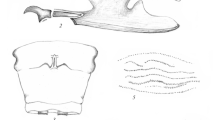Abstract
The biology of the earwig,Doru taeniatum (Dohrn), a reported predator ofSpodoptera frugiperda (J. E. Smith), was studied in the laboratory.D. taeniatum under laboratory conditions was easily reared, mated readily and females tended eggs and first instar nymphs.D. taeniatum developed through 4 nymphal instars and reached imago in approximately 30 days. It is an omnivore in the laboratory and capable of developing and reproduction on plant pollen alone, and on Lepidoptera eggs (Sitotroga carealella) (Olivier) alone. Immatures developed most rapidly and females were most fecund when fed either a combination ofS. cereallea eggs and pollen, orS. cerealella eggs alone.
Résumé
La biologie du perce oreille,Doru taeniatum (Dohrn) prédateur signalé deSpodoptera frugiperda (J. E. Smith) a été étudiée au laboratoire. Dans les conditions du laboratoire,D. taeniatum s'élevait facilement, s'accouplait rapidement et les ♂ ♂ prenaient soin des œufs et des premiers stades larvaires.D. taeniatum passait par 4 stades larvaires et atteignait le stade adulte en 30 jours environ. C'est un omnivore au laboratoire, capable de se développer et de se reproduire soit sur le pollen des plantes seul, soit sur les œufs de Lépidoptères (Sitotroga cerealella) seuls. Les stades immatures se développaient le plus vite et les ♂ ♂ étaient les plus fécondes quand la nourriture était soit une combinaison d'œufs deS. cerealella et de pollen, soit des œufs deS. cerealella seuls.
Similar content being viewed by others
References
Ammar, E. D. &Farrag, S. M. — 1974. Studies on the behavior and biology of the earwigLabidura riparia Pallas [Derm.: Labiduridae]. —Z. Angew. Entomol., 75, 189–96.
Andrews, K. L. — 1980. The whorlworm,Spodoptera frugiperda in Central America and neighboring areas. —Fla. Entomol., 63, 456–67.
Birch, L. C. — 1948. The intrinsic rate of natural increase of an insect population. —J. Anim. Ecol., 17, 15–26.
Brindle, A. — 1971. A revision of the genusDoru Burr [Dermaptera: Forficulidae]. —Papeis de Zoologia, 23, 173–96.
Buxton, J. H. &Madge, D. S. — 1976. The evaluation of the European earwig as a predator of the damson hop aphid,Phorodan humuli. I. Feeding experiments. —Entomol. Exp. & Appl., 19, 109–14.
Campbell, C. A. M. — 1978. Regulation of the damson-hop aphid [Phorodon humuli (Schrank)] on hops (Humulus lupulus L.) by predators. —J. Hort. Sci., 53, 235–42.
Carroll, D. P. &Hoyt, S. C. — 1984. Augmentation of european earwigs [Dermaptera: Forficulidae] for biological control of apple aphid [Homoptera: Aphididae] in an apple orchard. —J. Econ. Entomol., 77, 738–40.
Fulton, B. B. — 1924. Some habits of earwigs. —Ann. Entomol. Soc. Am., 18, 357–67.
Giles, E. T. — 1970. Dermaptera. In: Insects of Australia. pp. 306–13. —Melbourne University Press, Carlton, Victoria, Australia.
Gurney, A. B. — 1972. Important recent name changes among the earwigs of the genusDoru. —U.S.D.A. Coop. Econ. Insect Rep., 22, 182–5.
Luginbell, P. — 1928. The fall armyworm. —U.S.D.A. Tech. Bull., No. 34.
Marrucci, P. — 1955. Notes on the predatory habits and life cycle of two Hawaiian earwigs. —Proc. Hawaiian Entomol. Soc., 15, 565–9.
Painter, R. — 1955. Insects on corn and teosinte in Guatemala. —J. Econ. Entomol., 48, 36–42.
Passoa, S. — 1983. Lista de los insectos asociados con los granos básicos y otros cultivos selectos en Honduras. —Ceiba, 25, 1–97.
Popham, E. J. — 1965. The functional morphology of the reproductive organs of the common earwig,Forficula auricularia and other Dermaptera with reference to the natural classification of the order. —J. Zool., 146, 1–43.
Price, J. F. &Shepard, M. — 1977. Striped earwig,Labidura riparia colonization of soybean fields and response to insecticides. —Environ. Entomol., 6, 679–83.
Sakai, S. — 1973. Derapterorum Catalogus Praeliminaris. VII. pp. 214–26. —Ikegami Book Co., Tokyo, Japan.
Shepard, M., Waddill, V. &Kloft, W. — 1973. Biology of the predaceous earwigLabidura riparia [Dermaptera: Labiduridae]. —Ann. Entomol. Soc. Am., 66, 837–41.
Strandberg, J. O. — 1981. Predation of cabbage looper,Trichoplusia ni, pupae by the striped earwig,Labidura riparia, and two bird species. —Environ. Entomol., 10, 712–5.
Van Huis, A. — 1981. Integrated pest management in the small farmer's maize crop in Nicaragua. —Med. Land., Wageningen, 81–6 (1981), 94–6.
Author information
Authors and Affiliations
Additional information
Approved as TA 20744 by Director, Texas Agricultural Experiment Station.
Rights and permissions
About this article
Cite this article
Jones, R.W., Gilstrap, F.E. & Andrews, K.L. Biology and life tables for the predaceous earwig,Doru taeniatum [Derm.: Forficulidae]. Entomophaga 33, 43–54 (1988). https://doi.org/10.1007/BF02372312
Received:
Accepted:
Issue Date:
DOI: https://doi.org/10.1007/BF02372312




